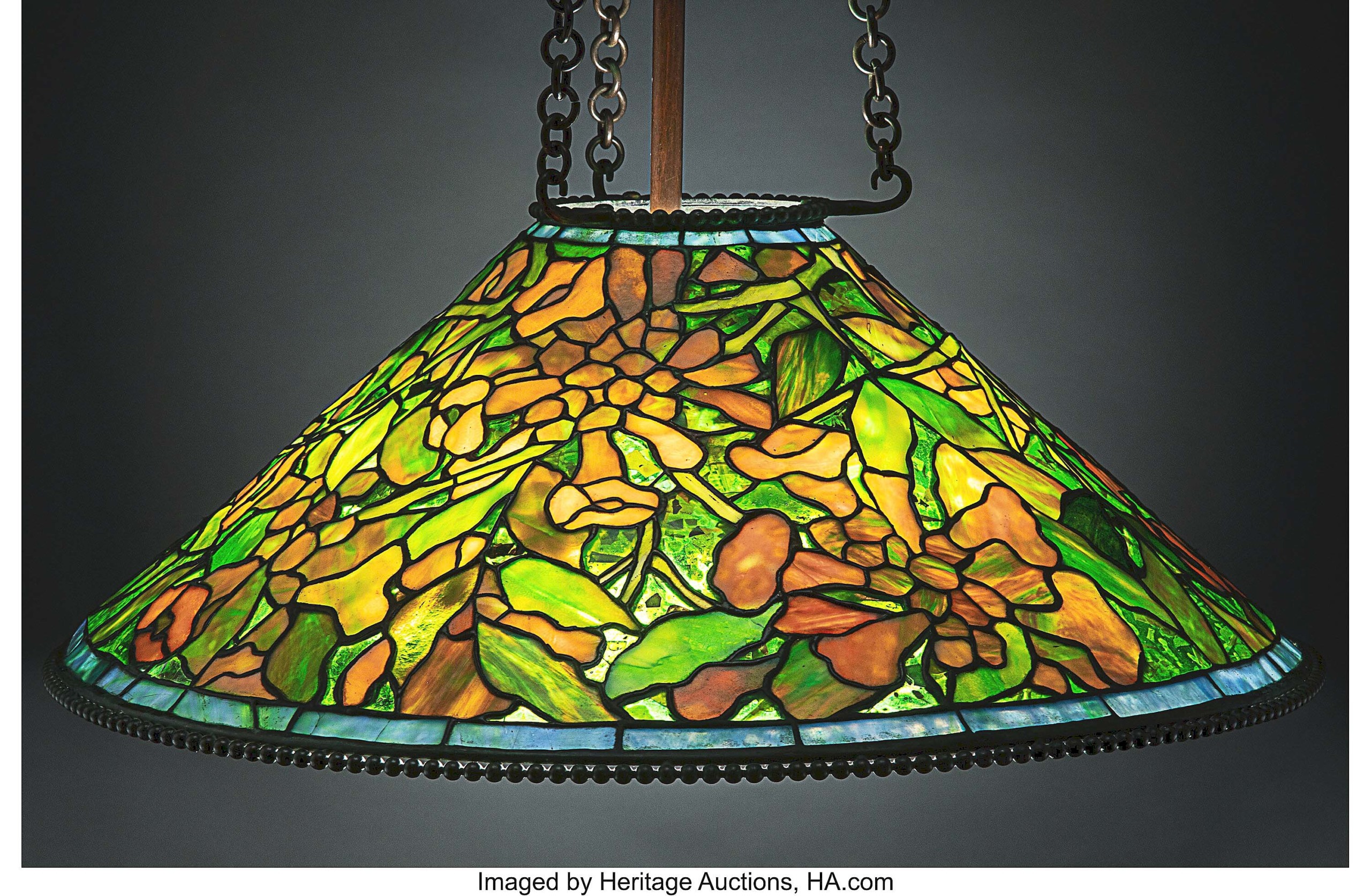
Achieving $137,500, the sale’s highest price, was this Tiffany Studios Trumpet Creeper chandelier, circa 1910, leaded glass and patinated bronze ($150/200,000). The shade measured 10 by 25 inches.
Review by Carly Timpson
DALLAS — Heritage Auctions’ April 18 Pursuit of Beauty auction offered works from the late Nineteenth and early Twentieth Centuries across all media and featured collections of art glass, art pottery, including Martinware and property from the collection of Ruth Sylvia Nelkin, Stamford, Conn., and New York City. The 454-lot sale had nearly 3,000 registered bidders and, with a 98 percent sell-through rate, grossed $1,335,740, meeting the sale’s high estimate.
Samantha Robinson, Heritage’s director of Decorative Arts and Design, said, “These strong results demonstrate Heritage’s ability to secure consignments from private collections and estates nationwide and present the fresh-to-the-market wares to our vast network of bidders. In today’s market, the finest and rarest pieces — from Tiffany Studios lamps to French pâte de verre to Martin Brothers grotesques — continue to garner attention, excitement and fierce competition and achieve high hammer prices as a result.”
As expected, the highest-achieving lot in the sale was a rare Tiffany Studios Trumpet Creeper chandelier, which was bid to $137,500, just shy of its $150,000 low estimate. The leaded glass and patinated bronze “hanger” measured 10 by 25 inches and came from a Palm Beach Gardens, Fla., collection. Heritage Auction’s pre-sale press release described the circa 1910 chandelier’s design as “graphically stunning in undulating earth tones ringed with sky-blue.” A similar example of this shade can be found in the 2019 book Tiffany Lamps and Metalware: An Illustrated Reference to Over 2000 Models by Alastair Duncan.
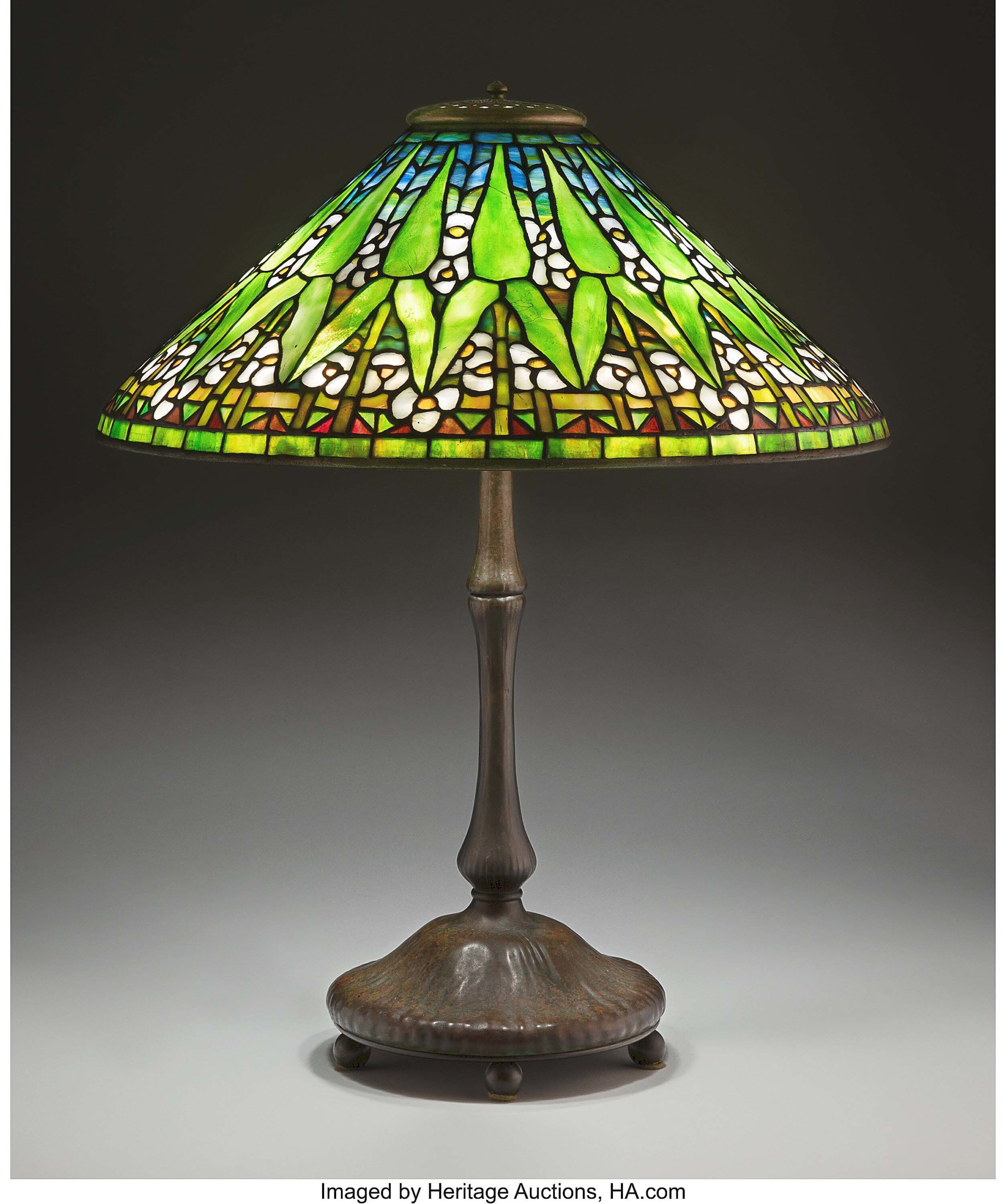
This Tiffany Studios Arrowroot table lamp with base numbered “394,” leaded glass and patinated bronze, 25½ by 20½ inches, found a buyer for $32,500 ($30/40,000).
Several other Tiffany Studios light fixtures finished with top-10 prices, including an Arrowroot table lamp and a seven-light Lily lamp, both included in Duncan’s resource. With a repeating motif of green leaves and white flowers ground in blues, greens and yellows, the Arrowroot shade was paired with a ribbed three-light base marked “Tiffany Studios/New York/394” and found a buyer for $32,500. The Lily lamp featured seven iridescent Favrile glass Lily shades, each marked “L.C.T.” and individually stemming from the gilt bronze Lily Pad base, which was marked “Tiffany Studios/New York/385.” At 21 inches tall and 12½ inches wide, the circa 1910 lamp went out for $25,000 ($8/10,000).
Another highlight of the sale was a “rare and monumental” red-on-cream cameo glass vase by Émile Gallé in the Calla Lily design. As reported in the auction catalog, the circa 1920 vase is “one of the most iconic of the mold-blown or soufflé designs produced by Gallé following World War I” — a similar example is depicted in Glass by Gallé by Alastair Duncan and Georges De Bartha. Blown into a mold and cut with acid, this Calla Lily design featured crimson blossoms on deep oxblood leaves against a buttercream to yellow-amber ground. With a Camard Dimer label affixed to its underside, the signed vase earned $52,500.
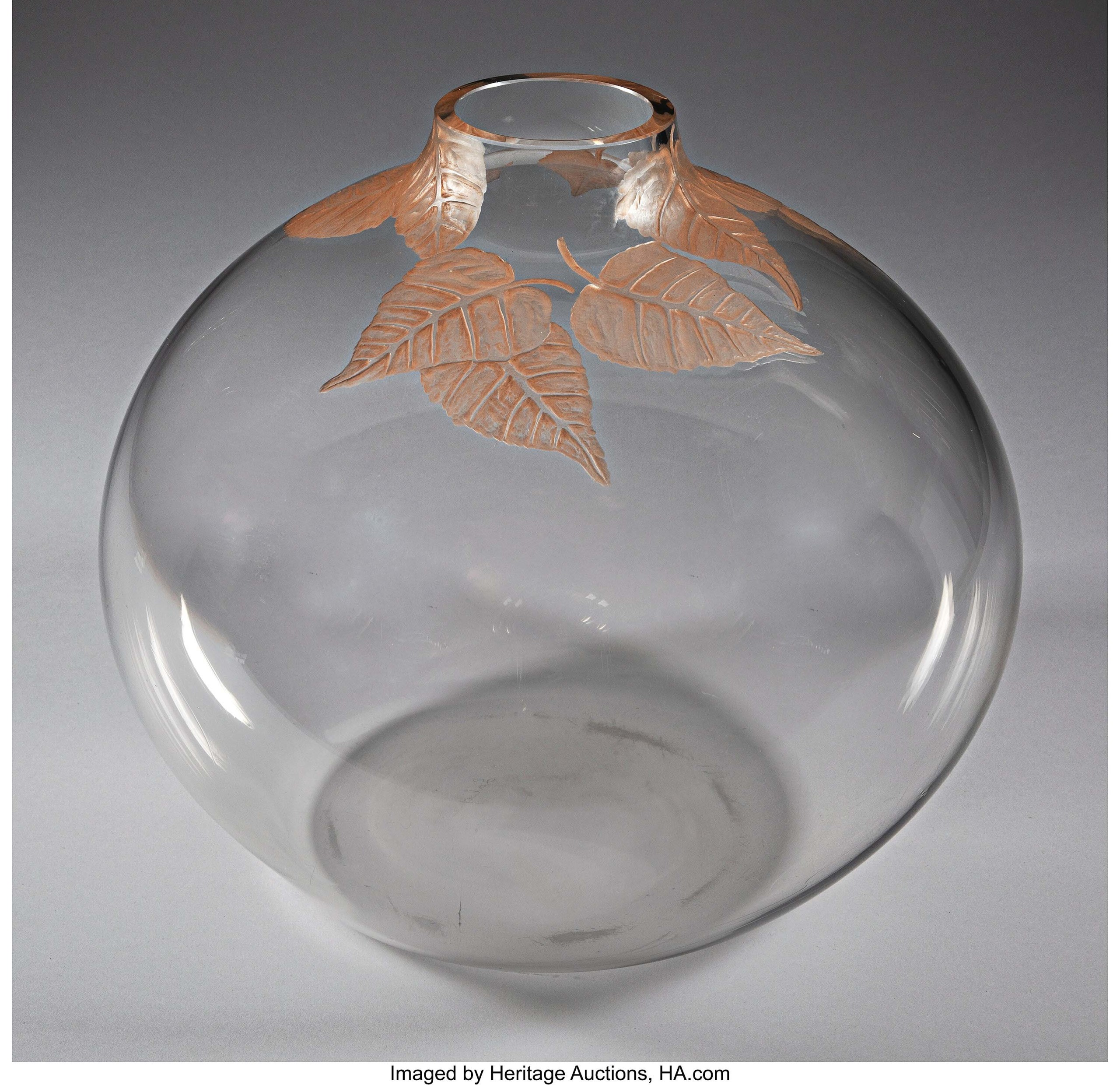
A René Lalique clear glass artistic vase with sepia patina engraved leaves, circa 1919, 11½ by 12¼ inches, earned $50,000 ($7/9,000).
Finishing at $50,000 — blowing past its $7/9,000 estimate — was a round glass vase by René Lalique. The circa 1919 vase was blown colorless glass with hand-engraved sepia leaves encircling its narrow neck. Signed “Lalique” on its bottom, the vase was in good condition with no signs of damage or restoration. Nicholas Dawes, senior vice president of special collections, said, “There were two bidders, one European and the other from the United States, competing heavily with each other. This sale proves the market is strong for academic or unique Lalique glass — while most Lalique is factory-made, this was an especially good unique piece.”
The late Ruth Nelkin was a philanthropist who, over decades, amassed a substantial collection of art, antiques and jewels. The featured lots comprised virtuoso French art glass, including the rare pâte de verre. Represented among top lots by the even rarer subcategory of illuminated pieces, a pâte de verre and wrought iron La Prairie lamp by Gabriel Argy-Rousseau, with a domed red and violet mottled glass shade, made $40,000. A similar example of this circa 1926 lamp is illustrated in Janine Bloch-Dermant’s 1991 text, G. Argy-Rousseau: Glassware as Art. As Dawes stated, “The results show that the demand for these pieces greatly exceeds the supply.” All 30 lots from the Nelkin collection successfully changed hands, the collection as a whole exceeded its high estimate and Dawes commented that all proceeds from those sales will be donated to charity.
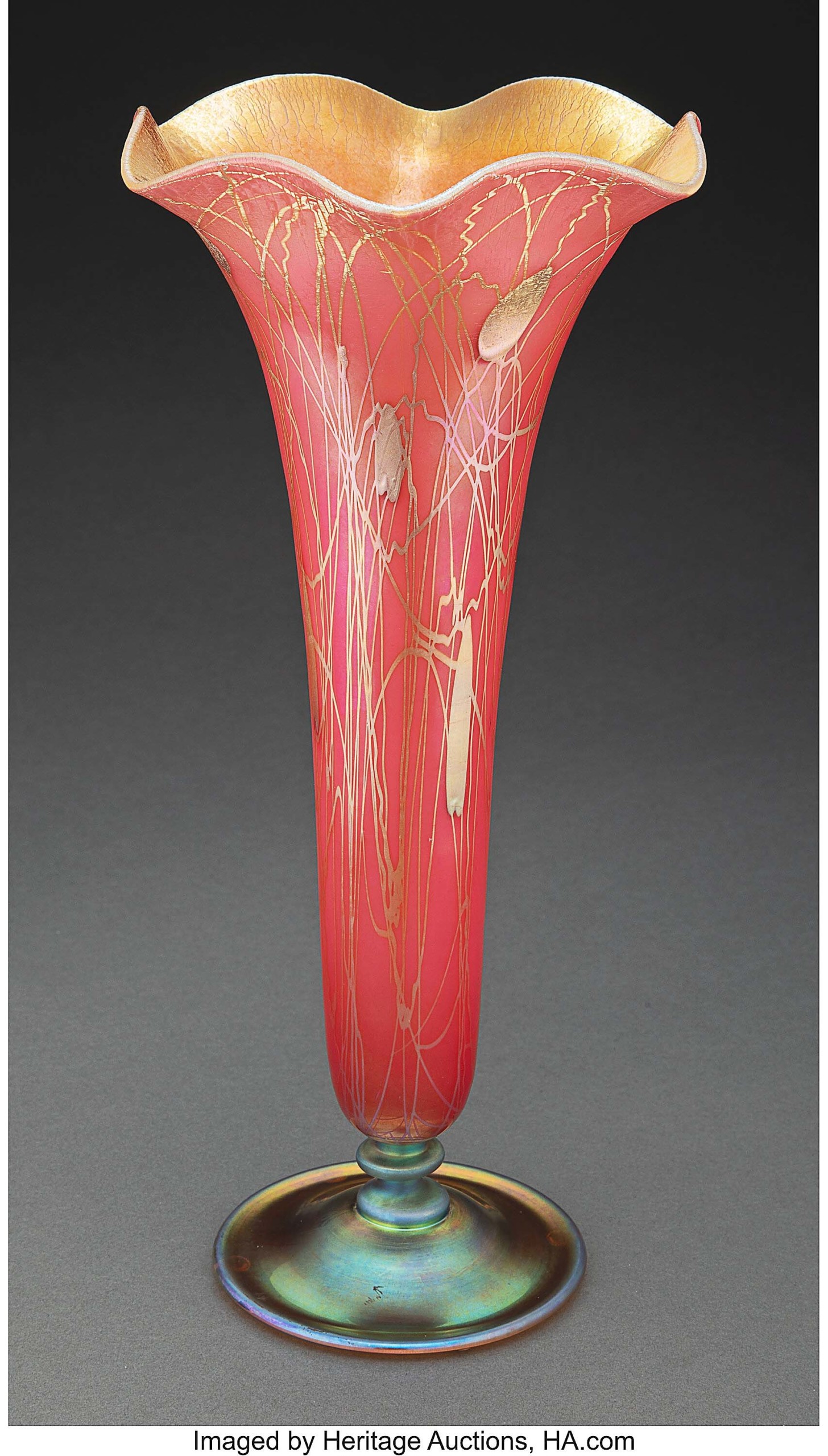
A Steuben decorated red Aurene glass footed vase, circa 1910, marked “Aurene” and “547,” 12¼ inches tall, made $37,500 ($40/50,000).
Also offered was a “very good collection of Steuben glass.” In fact, Dawes said it was “the best collection to come to market, possibly ever, and it is evidence that there is strength in the Steuben market. Steuben made a lot of glass, but this collection was very carefully curated to represent the best of its time.” Given that these Steuben glass pieces are more than 100 years old, “the fact that they’ve survived is pretty remarkable,” said Dawes. The top lot from that collection was an Aurene footed trumpet vase with noted provenance that included the collection of Rockwell Museum in Corning, N.Y., bequeathed by Frank and Mary Reifschlager, and the estate of Mr and Mrs Alan Shovers. The vase’s ruby-over-white body was embellished with applied gold leaf and vine motifs reflecting a blue iridescence that transitioned to pink and purple as the golden design sprawled to the vase’s ruffled rim. On an applied Aurene foot, the vase stood just over a foot tall and sold for $37,500.
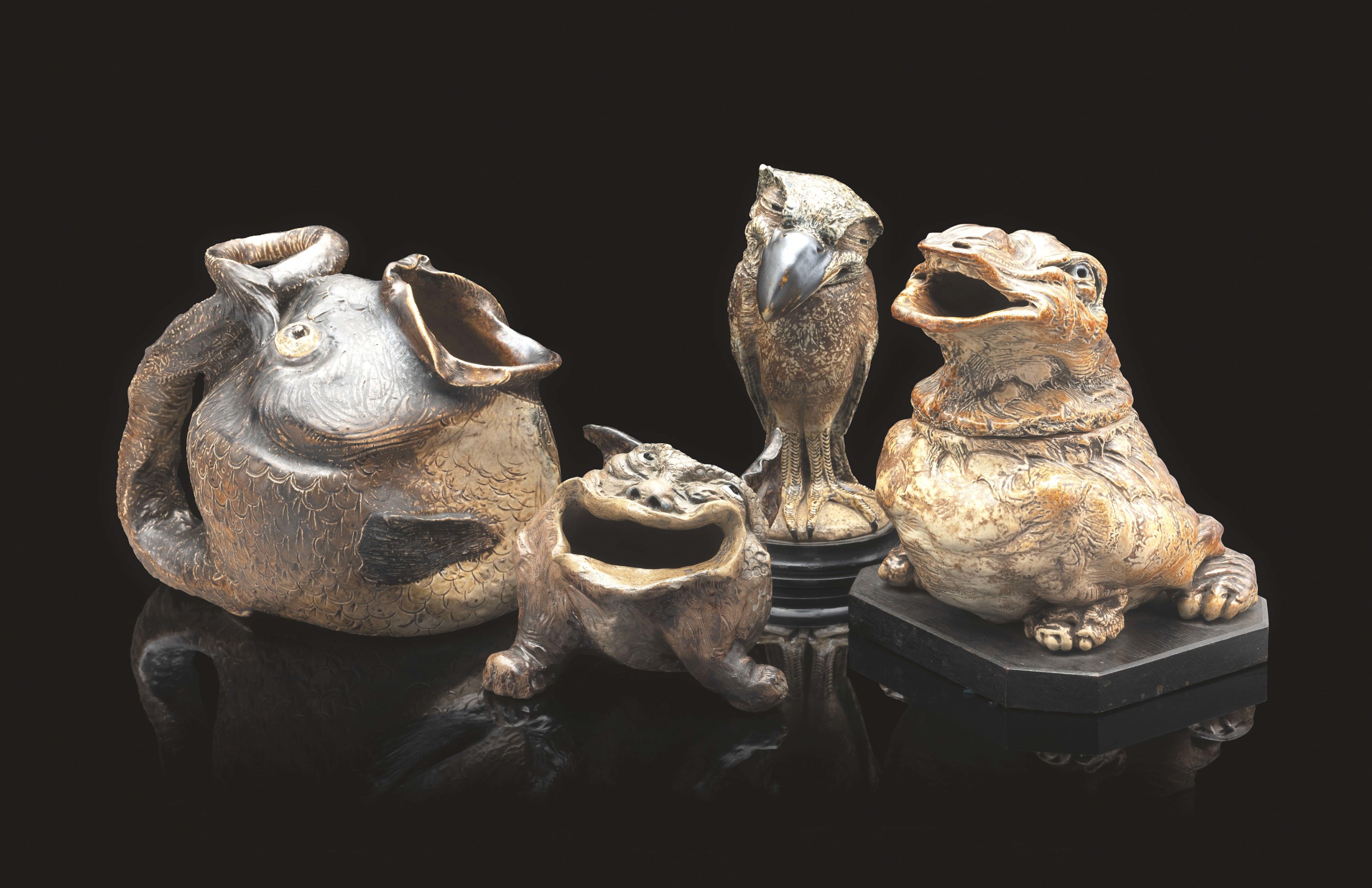
Several pieces of salt-glazed stoneware by Robert Wallace Martin for Martin Brothers brought success in the sale. From left to right: a Grotesque Fish spoon warmer, by Robert Wallace Martin, 1883, 8-5/8 by 7¾ by 11 inches, was taken to $28,750; a Grotesque figural spoon warmer, by Robert Wallace Martin, 1885, approximately 4¾ by 6 by 7 inches, made $15,000; a Wally Bird tobacco jar, circa 1890, 8½ by 4 by 5 inches, brought $9,375; and a Grotesque figural jar, by Robert Wallace Martin, 1901, 8-3/8 by 6½ by 7½ inches, earned the group’s highest price: $30,000.
Twelve pieces of fresh-to-market Martin Brothers (London, 1873-1914) art pottery — known as Martinware — from a private American collection of more than 100 lots of early Twentieth Century art pottery, were offered, including several vases and figural jars. For many Martinware collectors, the stranger the better. Fortunately, the sale offered a Grotesque tobacco jar in the shape of an unidentified creature with four legs, a beak and a squat scaly body. This 1901 salt-glazed jar by Robert Wallace Martin led the selection, achieving $30,000. Finishing right behind the mystery creature at $28,750 was a Grotesque Fish spoon warmer, also marked by R.W. Martin. In the form of an open-mouthed bulbous fish with an upward-curved tail handle, the large spoon warmer was cataloged as “a strong example of Martin Brothers’ whimsical style, featuring finely carved details and exaggerated expression.” Dawes reported that bids on Martinware were predominantly placed from the United Kingdom and United States, with most of the higher-end pieces being sold to a private collector in the U.K.
Prices quoted include the buyer’s premium as reported by the auction house. On May 11, Heritage Auctions will conduct auctions of vintage Disney animation drawings and fine minerals. For information, www.ha.com or 877-437-4824.












